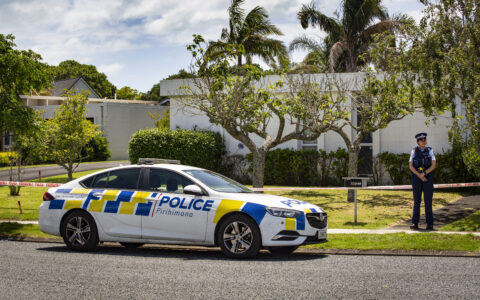
WARNING – THIS STORY CONTAINS GRAPHIC DETAILS
Jury members have heard from an expert witness about where blood was found inside a murdered east Auckland businesswoman’s house after her death.
Fang Sun is on trial before Justice Neil Campbell and a jury at the Auckland High Court charged with the murder of Elizabeth (Ying) Zhong, who lived in Suzetta Place, Sunnyhills, at the time of her violent killing in late 2020.
Sun has pleaded not guilty to murder. His trial got under way on April 26.
The Crown case is being presented by prosecutors Gareth Kayes and Sam Becroft.
Defence lawyers Sam Wimsett, Yvonne Mortimer-Wang and Honor Lanham are representing Sun.
The court previously heard Zhong and Sun met in 2012 and went into business together in 2014, setting up a company named Sunbow Limited.
They had shared interests in various businesses including in film production and vineyards.
Their business relationship soured when their joint companies fell into debt.
Sun took a civil litigation against Zhong alleging she owed him and his family millions of dollars.
He hired a private investigator to track her movements and send him updates on her whereabouts.
Sun was living at a property in Fisher Parade, a short distance from Zhong’s home, at the time of her death.
She was reported missing to police on the morning of November 28, 2020.
Police found her body later the same day inside the boot of her Land Rover vehicle parked in Roadley Avenue around the corner from her home.
She was wrapped in a blanket and had a suitcase placed on top of her body.
Zhong had been stabbed in the head, neck and back more than 20 times.
The Crown alleges Sun killed Zhong in the early hours of November 28, 2020, after they fell out due to their failed business ventures.
The defence case is Sun is innocent and Zhong was killed by someone else.
In court on May 23 at the start of week five of Sun’s trial, the jury heard from a police detective constable tasked on November 30, 2020, with locating Zhong’s ex-partner David Zheng.
Two officers went to Zheng’s Auckland home but he wasn’t there.
They reached him on the phone and arranged to meet him at a police station where they interviewed him.
The officer said he observed during the interview that Zheng had no visible injuries to his face or hands.
Zheng told police the last time he was at Zhong’s house was in September 2020, he said.
The officer said Zheng voluntarily provided a sample of his DNA to police, and his fingerprints and allowed himself to be photographed by police.
The next witness to give evidence was senior forensic scientist Fiona Matheson.
She told the court she was involved with scene examinations at Zhong’s Suzetta Place home, Sun’s property in Fisher Parade, the location where Zhong’s vehicle was found in Roadley Avenue, an address in Auckland CBD, and of two vehicles, including one used by Sun.
She also examined a laptop computer found in Zhong’s vehicle and the suitcase that had been placed on top of her body.
Kayes asked Matheson about her examination of Zhong’s bedroom.
Matheson said she noted blood on both cabinets beside the bed.
One of them had a bloodstain on its top drawer by the knob.
The bloodstain had a “linear striated pattern”, which Matheson said meant it was striped, and it had a fabric appearance.
“You could assume [it was caused] by a hand wearing a glove given it’s next to a handle, or bloodstained fabric on another part of the body that happened to touch that area.”
Matheson said the other bedside cabinet had blood staining by the knob also.
A lamp sitting on the cabinet had bloodstains on its switch, cord, and face.
She said one of the pillows on Zhong’s bed had been moved and had blood on either side.
Blood was observed on the top surface of the bedding at the foot of Zhong’s bed.
Matheson said blood in one area of a pillow was created by contact with a bloodstained fabric.
She said she observed two “heavy” blood stains measuring 9cm by 14cm on the side of the bed aligning with the front of a cabinet.
“Both contained features that indicate they were created by contact with bloodstained fabric,” Matheson said.
“At the time of investigation I considered it could be a bloodstained knee contacting the area twice, or two separate bloodied knees.”
The trial continues and is expected to take about six weeks.










